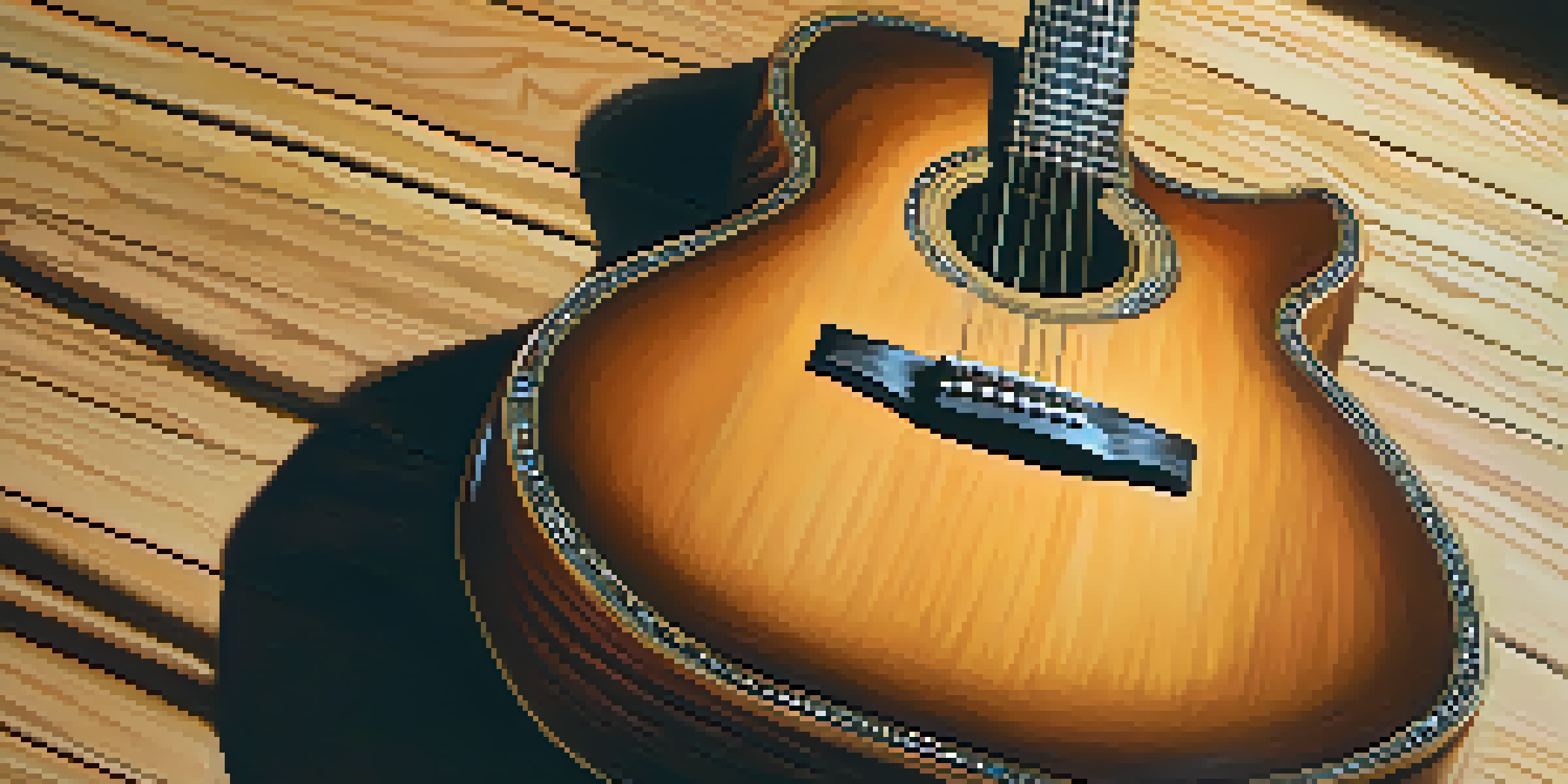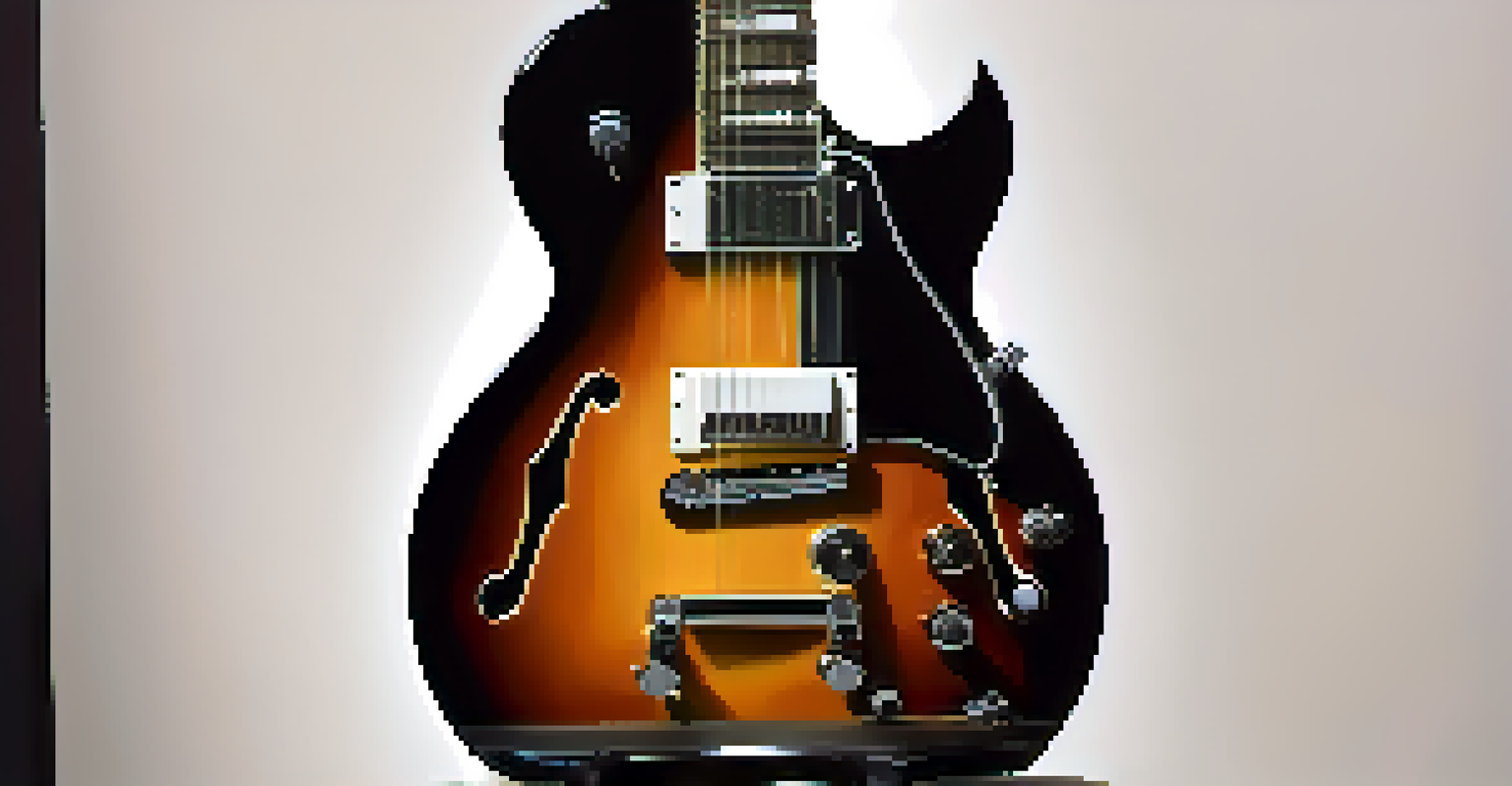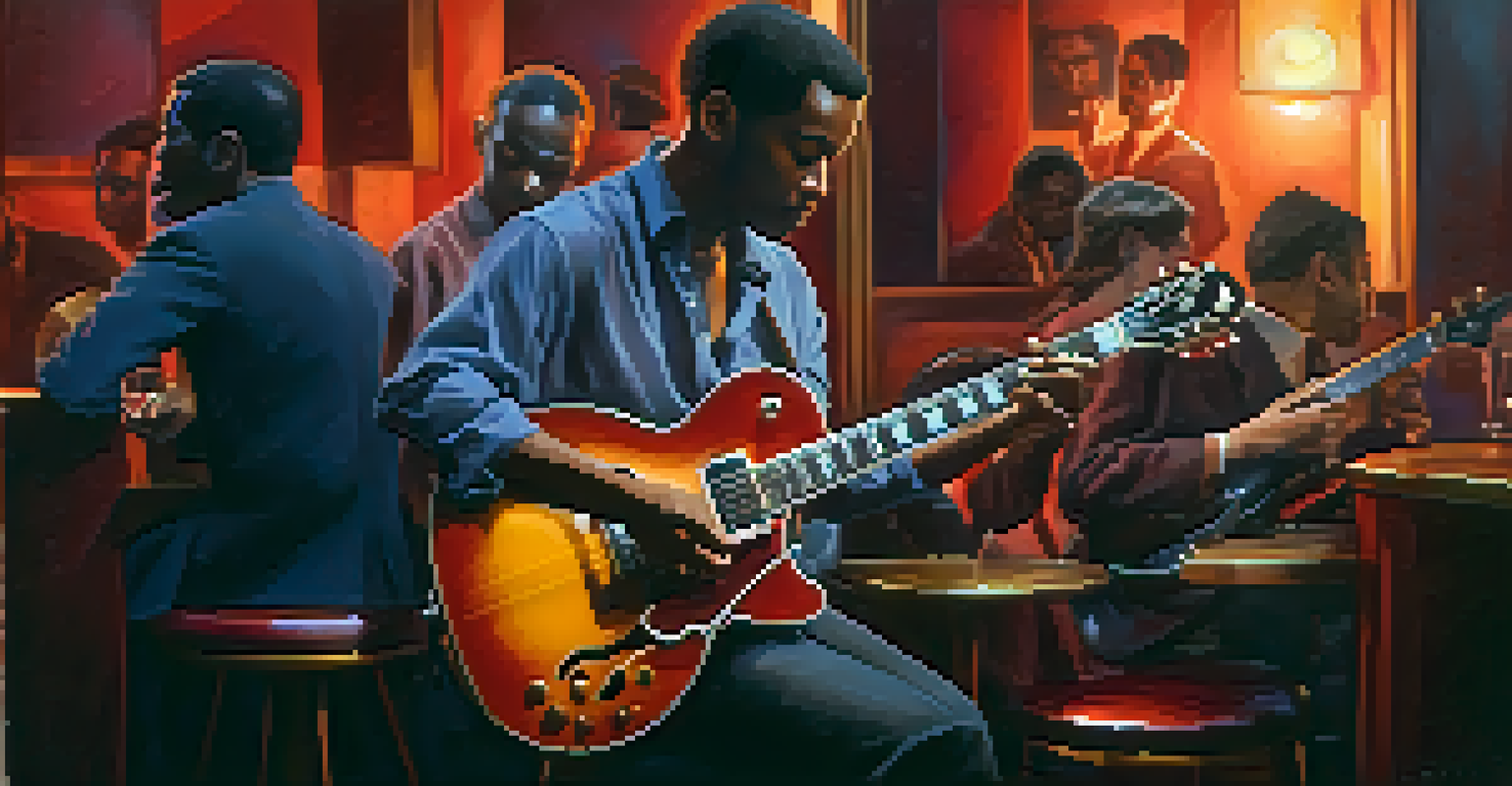Hollow Body vs. Solid Body: Recent Advances in Design

Understanding Hollow Body and Solid Body Guitars
Hollow body and solid body guitars represent two distinct approaches to design, each with its own unique sound and playing style. Hollow body guitars, often favored in jazz and blues, have a resonant chamber that amplifies sound acoustically. In contrast, solid body guitars are typically used in rock and pop genres for their sustain and feedback control. Understanding these differences is crucial for musicians when choosing an instrument that suits their style.
The beauty of music is that it can be a reflection of who you are, and your choice of guitar can define your sound.
The hollow body design features a wooden shell that is often lighter and more resonant, offering a warm and airy tone. This allows for a rich harmonic response, making it a popular choice for expressive soloing and chord progressions. Solid body guitars, on the other hand, are constructed from a single piece of wood or layered materials, providing a denser sound that can handle high volumes without distortion.
Ultimately, the choice between hollow and solid body guitars boils down to personal preference and musical genre. While both types have their strengths, musicians should consider how each design complements their playing style and the sound they wish to produce.
Recent Advances in Hollow Body Guitar Design
Recent innovations in hollow body guitar design have focused on enhancing playability and sound quality. Manufacturers are experimenting with new materials, such as carbon fiber and advanced composites, to create lighter, more durable instruments that retain the classic hollow body sound. These materials can also improve resonance and sustain, allowing players to explore a wider range of tones.

Additionally, technology has played a significant role in hollow body design advancements. Many guitars now feature built-in pickups and amplification systems that capture the acoustic qualities of the instrument while providing versatility for live performances. This integration allows musicians to switch seamlessly between acoustic and electric sounds.
Hollow vs Solid: Sound Differences
Hollow body guitars offer warm, resonant tones ideal for jazz, while solid body guitars deliver sharp clarity suited for rock.
These innovations are making hollow body guitars more appealing to a broader audience, from seasoned professionals to beginners. As technology continues to evolve, we can expect further enhancements that will push the boundaries of what hollow body guitars can achieve.
Solid Body Guitars: Technological Breakthroughs
Solid body guitars have seen their fair share of technological advancements that cater to the modern musician's needs. One of the most significant developments is the introduction of active pickups, which provide higher output and a more dynamic range of tones. These pickups can enhance clarity and allow for greater versatility across different musical styles.
A guitar is more than just an instrument; it's an extension of the musician's soul.
Another notable trend is the use of CNC (Computer Numerical Control) technology in manufacturing, which enables precise shaping and cutting of wood. This ensures consistent quality and allows for intricate designs that were previously difficult to achieve. The result is a solid body guitar that not only looks stunning but also delivers exceptional sound performance.
As players seek more customization options, many brands now offer solid body guitars with interchangeable components. Musicians can easily swap out pickups, bridge systems, and other features to tailor their instrument to their specific preferences, making solid body guitars more versatile than ever before.
Comparative Sound Qualities of Both Designs
When it comes to sound, hollow body and solid body guitars produce distinctly different tones that can shape a musician's overall sound palette. Hollow body guitars are known for their warm, resonant sound with pronounced mid-range frequencies, making them suitable for genres that require a smooth, melodic touch. This rich sound can be ideal for expressive leads and soft rhythms.
On the contrary, solid body guitars typically generate a sharper, more focused sound that emphasizes brightness and clarity. This makes them particularly effective for high-gain styles such as rock and metal, where clarity in the midst of distortion is crucial. The sustain produced by solid body guitars also lends itself well to feedback manipulation during performances.
Innovations Enhance Guitar Playability
Recent advances in materials and technology have improved the playability and sound quality of both hollow and solid body guitars.
Understanding these sound qualities helps players make informed choices about which guitar to use for specific genres or playing styles. Each design offers its unique advantages, allowing musicians to select an instrument that best fits their artistic vision.
Ergonomics and Playability: A Key Factor
Ergonomics and playability are critical considerations when choosing between hollow body and solid body guitars. Hollow body guitars are generally lighter and can be easier to handle, especially for extended playing sessions. Their shape often allows for greater comfort when playing seated, making them a favorite among jazz and blues musicians who perform for long periods.
In contrast, solid body guitars are typically heavier, which can be a consideration for some players. However, many solid body models are designed with contours and weight distribution to enhance playability. Features such as cutaways allow for easier access to higher frets, which is essential for lead guitarists.
Ultimately, the choice of guitar should match the player's comfort level and style. Trying out different models can help musicians discover the design that feels most natural in their hands, enhancing their overall playing experience.
Aesthetic Appeal: Style Meets Function
Aesthetic appeal is another important factor for many musicians when choosing between hollow body and solid body guitars. Hollow body guitars often boast beautiful finishes, intricate inlays, and unique shapes that make them visually striking on stage. Their vintage look can evoke a sense of nostalgia, appealing to players who value classic aesthetics.
Solid body guitars, while sometimes seen as more utilitarian, have also embraced artistic design in recent years. Custom finishes, graphic designs, and unique body shapes allow musicians to express their individuality through their instruments. Many brands now offer options for personalized artwork, making solid body guitars equally as appealing from a visual standpoint.
Choose Based on Style and Comfort
Selecting the right guitar involves considering your musical genre, playing style, and personal comfort for optimal performance.
Ultimately, the aesthetics of a guitar can enhance a player's connection to their instrument, inspiring creativity during performances. Whether it's the classic charm of a hollow body or the modern flair of a solid body, the visual aspect is an essential element of the overall experience.
Choosing the Right Guitar for Your Needs
Choosing between a hollow body and a solid body guitar can feel overwhelming, especially with so many options available. To make an informed decision, musicians should consider their primary playing style, genre, and sound preferences. For example, a jazz musician may lean towards a hollow body for its warm tones, while a rock guitarist might prefer a solid body for its sustain and clarity.
Another key factor is the environment in which the guitar will be used. If you frequently play in loud settings or with a band, a solid body guitar might be more suitable due to its feedback resistance. Conversely, if you often play solo or in acoustic settings, a hollow body could provide the depth and resonance you need.

Ultimately, trying out different models in-store, or even renting before buying, can lead to the best decision. The right guitar should feel comfortable and inspire confidence, allowing musicians to express themselves fully through their music.